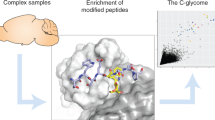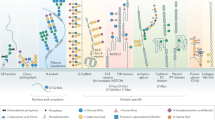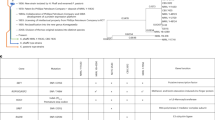Abstract
Yeast and other fungal protein-expression hosts have been extensively used to produce industrial enzymes, and are often the expression system of choice when manufacturing costs are of primary concern. However, for the production of therapeutic glycoproteins intended for use in humans, yeast have been less useful owing to their inability to modify proteins with human glycosylation structures. Yeast N-glycosylation is of the high-mannose type, which confers a short half-life in vivo and thereby compromises the efficacy of most therapeutic glycoproteins. Several approaches to humanizing yeast N-glycosylation pathways have been attempted over the past decade with limited success. Recently however, advances in the glycoengineering of yeast and the expression of therapeutic glycoproteins with humanized N-glycosylation structures have shown significant promise — this review summarizes the most important developments in the field.
This is a preview of subscription content, access via your institution
Access options
Subscribe to this journal
Receive 12 print issues and online access
$209.00 per year
only $17.42 per issue
Buy this article
- Purchase on Springer Link
- Instant access to full article PDF
Prices may be subject to local taxes which are calculated during checkout





Similar content being viewed by others
References
Nasmyth, K. Eukaryotic gene cloning and expression in yeast. Nature 274, 741–743 (1978).
Sudbery, P. E. The expression of recombinant proteins in yeasts. Curr. Opin. Biotechnol. 7, 517–524 (1996).
Gellissen, G. & Hollenberg, C. P. Application of yeasts in gene expression studies: a comparison of Saccharomyces cerevisiae, Hansenula polymorpha and Kluyveromyces lactis — a review. Gene 190, 87–97 (1997).
Cregg, J. M., Vedvick, T. S. & Raschke, W. C. Recent advances in the expression of foreign genes in Pichia pastoris. Biotechnology 11, 905–910 (1993).
Cregg, J. M. & Higgins, D. R. Production of foreign proteins in the yeast Pichia pastoris. Can. J. Bot. 73, S891–S897 (1995).
Gellissen, G. & Melber, K. Methylotrophic yeast Hansenula polymorpha as production organism for recombinant pharmaceuticals. Arzneimittelforschung 46, 943–948 (1996).
Werten, M. W. T., Van den Bosch, T. J., Wind, R. D., Mooibroek, H. & De Wolf, F. A. High-yield secretion of recombinant gelatins by Pichia pastoris. Yeast 15, 1087–1096 (1999).
Young, N. M. et al. Structure of the N-linked glycan present on multiple glycoproteins in the Gram-negative bacterium, Campylobacter jejuni. J. Biol. Chem. 277, 42530–42539 (2002).
Szymanski, C. M., Yao, R. J., Ewing, C. P., Trust, T. J. & Guerry, P. Evidence for a system of general protein glycosylation in Campylobacter jejuni. Mol. Microbiol. 32, 1022–1030 (1999).
Wacker, M. et al. N-linked glycosylation in Campylobacter jejuni and its functional transfer into E. coli. Science 298, 1790–1793 (2002). This is the first paper to describe transfer of a prokaryotic N -glycosylation machinery from C. jejuni to E. coli.
Thibault, P. et al. Identification of the carbohydrate moieties and glycosylation motifs in Campylobacter jejuni flagellin. J. Biol. Chem. 276, 34862–34870 (2001).
McAleer, W. J. et al. Human hepatitis B vaccine from recombinant yeast. Nature 307, 178–180 (1984).
Walsh, G. Biopharmaceutical benchmarks — 2003. Nature Biotechnol. 21, 1396 (2003).
Humphreys, A. & Boersig, C. Cholesterol drugs dominate. MedAdNews 22, 42–57 (2003).
Yuen, C. T., Carr, S. A. & Feizi, T. The spectrum of N-linked oligosaccharide structures detected by enzymatic microsequencing on a recombinant soluble CD4 glycoprotein from Chinese hamster ovary cells. Eur. J. Biochem. 192, 523–528 (1990).
Ulloa-Aguirre, A., Timossi, C., Barrios-de-Tomasi, J., Maldonado, A. & Nayudu, P. Impact of carbohydrate heterogeneity in function of follicle-stimulating hormone: studies derived from in vitro and in vivo models. Biol. Reprod. 69, 379–389 (2003).
Shields, R. L. et al. Lack of fucose on human IgG1 N-linked oligosaccharide improves binding to human Fcγ RIII and antibody-dependent cellular toxicity. J. Biol. Chem. 277, 26733–26740 (2002). This publication highlights the importance of glycosylation for antibody effector function.
Gentzsch, M. & Tanner, W. Protein O-glycosylation in yeast: protein-specific mannosyltransferases. Glycobiology 7, 481–486 (1997).
Lehle, L. & Bause, E. Primary structural requirements for N-glycosylation and O-glycosylation of yeast mannoproteins. Biochim. Biophys. Acta 799, 246–251 (1984).
Strahl-Bolsinger, S., Gentzsch, M. & Tanner, W. Protein O-mannosylation. Biochim. Biophys. Acta 1426, 297–307 (1999).
Ziegler, F. D., Gemmill, T. R. & Trimble, R. B. Glycoprotein synthesis in yeast early events in N-linked oligosaccharide processing in Schizosaccharomyces pombe. J. Biol. Chem. 269, 12527–12535 (1994).
Kornfeld, R. & Kornfeld, S. Assembly of asparagine-linked oligosaccharides. Annu. Rev. Biochem. 54, 631–664 (1985).
Burda, P. & Aebi, M. The dolichol pathway of N-linked glycosylation. Biochim. Biophys. Acta 1426, 239–257 (1999).
Gemmill, T. R. & Trimble, R. B. Overview of N- and O-linked oligosaccharide structures found in various yeast species. Biochim. Biophys. Acta 1426, 227–237 (1999). References 22, 23 and 24 are excellent reviews of N -linked glycosylation pathways in humans and yeast.
Tabas, I. & Kornfeld, S. Purification and characterization of a rat-liver golgi α-mannosidase capable of processing asparagine-linked oligosaccharides. J. Biol. Chem. 254, 1655–1663 (1979).
Herscovics, A. Structure and function of class I α1,2-mannosidases involved in glycoprotein synthesis and endoplasmic reticulum quality control. Biochimie 83, 757–762 (2001).
Herscovics, A. Importance of glycosidases in mammalian glycoprotein biosynthesis. Biochim. Biophys. Acta 1473, 96–107 (1999).
Tulsiani, D. R. P., Hubbard, S. C., Robbins, P. W. & Touster, O. α-D-mannosidases of rat-liver golgi membranes. Mannosidase-II Is the GlcNacMan5-cleaving enzyme in glycoprotein-biosynthesis and mannosidase-Ia and Mannosidase-Ib are the enzymes converting Man9 precursors to Man5 intermediates. J. Biol. Chem. 257, 3660–3668 (1982).
Moremen, K. W. & Robbins, P. W. Isolation, characterization, and expression of cDNAs encoding murine α-mannosidase-II, a golgi enzyme that controls conversion of high mannose to complex N-glycans. J. Cell Biol. 115, 1521–1534 (1991).
Bendiak, B. & Schachter, H. Control of glycoprotein-synthesis. Kinetic mechanism, substrate-specificity, and inhibition characteristics of UDP-N-acetylglucosamine-α-D-mannoside β-1-2 N-acetylglucosaminyltransferase-II from rat liver. J. Biol. Chem. 262, 5784–5790 (1987).
Schachter, H. The joys of HexNAc. The synthesis and function of N- and O-glycan branches. Glycoconjugate J. 17, 465–483 (2000).
Nakanishi-Shindo, Y., Nakayama, K., Tanaka, A., Toda, Y. & Jigami, Y. Structure of the N-linked oligosaccharides that show the complete loss of α-1,6-polymannose outer chain from Och1, Och1 Mnn1, and Och1 Mnn1 Alg3 mutants of Saccharomyces cerevisiae. J. Biol. Chem. 268, 26338–26345 (1993). This paper is the first successful attempt to eliminate yeast-specific N -glycan processing and to provide a human intermediate of N -glycan biosynthesis.
Chiba, Y. et al. Production of human compatible high mannose-type (Man5GlcNAc2) sugar chains in Saccharomyces cerevisiae. J. Biol. Chem. 273, 26298–26304 (1998). This paper describes the first successful attempt to target mannosidases to the secretory pathway of yeast and demonstrate some effect on N -linked glycan processing.
Kalsner, I., Hintz, W., Reid, L. S. & Schachter, H. Insertion into Aspergillus nidulans of functional UDP-GlcNac-α-3-D-mannoside β-1,2-N-acetylglucosaminyl-transferase-I, the enzyme catalyzing the first committed step from oligomannose to hybrid and complex N-glycans. Glycoconjugate J. 12, 360–370 (1995).
Martinet, W., Maras, M., Saelens, X., Jou, W. M. & Contreras, R. Modification of the protein glycosylation pathway in the methylotrophic yeast Pichia pastoris. Biotechnol. Lett. 20, 1171–1177 (1998).
van Vliet, C., Thomas, E. C., Merino-Trigo, A., Teasdale, R. D. & Gleeson, P. A. Intracellular sorting and transport of proteins. Prog. Biophys. Mol. Biol. 83, 1–45 (2003).
Gleeson, P. A. Targeting of proteins to the Golgi apparatus. Histochem. Cell Biol. 109, 517–532 (1998).
Harter, C. & Wieland, F. The secretory pathway: mechanisms of protein sorting and transport. Biochim. Biophys. Acta 1286, 75–93 (1996).
Teasdale, R. D. & Jackson, M. R. Signal-mediated sorting of membrane proteins between the endoplasmic reticulum and the Golgi apparatus. Annu. Rev. Cell Dev. Biol. 12, 27–54 (1996).
Pelham, H. R. B., Hardwick, K. G. & Lewis, M. J. Sorting of soluble ER proteins in yeast. EMBO J. 7, 1757–1762 (1988). Excellent early paper describing the sorting of proteins in the secretory pathway in the yeast Saccharomyces cerevisiae.
Munro, S. & Pelham, H. R. B. A C-terminal signal prevents secretion of luminal ER proteins. Cell 48, 899–907 (1987).
Dean, N. & Pelham, H. R. B. Recycling of proteins from the Golgi compartment to the ER in yeast. J. Cell Biol. 111, 369–377 (1990).
Lewis, M. J., Sweet, D. J. & Pelham, H. R. B. The ERD2 gene determines the specificity of the luminal ER protein retention system. Cell 61, 1359–1363 (1990).
Semenza, J. C., Hardwick, K. G., Dean, N. & Pelham, H. R. B. ERD2, a yeast gene required for the receptor-mediated retrieval of luminal ER proteins from the secretory pathway. Cell 61, 1349–1357 (1990).
Paulson, J. C. & Colley, K. J. Glycosyltransferases — structure, localization, and control of cell type-specific glycosylation. J. Biol. Chem. 264, 17615–17618 (1989).
Krezdorn, C. H. et al. Human β-1,4 galactosyltransferase and α-2,6 sialyltransferase expressed in Saccharomyces cerevisiae are retained as active enzymes in the endoplasmic reticulum. Eur. J. Biochem. 220, 809–817 (1994).
Schwientek, T., Lorenz, C. & Ernst, J. F. Golgi localization in yeast is mediated by the membrane anchor region of rat-liver sialyltransferase. J. Biol. Chem. 270, 5483–5489 (1995).
Yoshida, S. et al. Expression and characterization of rat UDP-N-acetylglucosamine: α-3-D-mannoside β-1,2-N-acetylglucosaminyltransferase I in Saccharomyces cerevisiae. Glycobiology 9, 53–58 (1999).
Nilsson, T. et al. Kin recognition between medial Golgi enzymes in HeLa cells. EMBO J. 13, 562–574 (1994).
Callewaert, N. et al. Use of HDEL-tagged Trichoderma reesei mannosyl oligosaccharide 1,2-α-D-mannosidase for N-glycan engineering in Pichia pastoris. FEBS Lett. 503, 173–178 (2001).
Bretthauer, R. K. Genetic engineering of Pichia pastoris to humanize N-glycosylation of proteins. Trends Biotechnol. 21, 459–462 (2003).
Choi, B. K. et al. Use of combinatorial genetic libraries to humanize N-linked glycosylation in the yeast Pichia pastoris. Proc. Natl Acad Sci. USA 100, 5022–5027 (2003).
Sharma, C. B., Knauer, R. & Lehle, L. Biosynthesis of lipid-linked oligosaccharides in yeast: the ALG3 gene encodes the Dol-P-Man:Man5GlcNAc2-PP-Dol mannosyltransferase. Biol. Chem. 382, 321–328 (2001).
Aebi, M., Gassenhuber, J., Domdey, H. & Heesen, S. T. Cloning and characterization of the ALG3 gene of Saccharomyces cerevisiae. Glycobiology 6, 439–444 (1996).
Davidson, R. C. et al. Functional analysis of the ALG3 gene encoding the Dol-P-Man:Man5GlcNAc2-PP-Dol mannosyltransferase enzyme of P. pastoris. Glycobiology 14, 399–407 (2004).
Bobrowicz, P. et al. Engineering of an artificial glycosylation pathway blocked in core oligosaccharide assembly in the yeast Pichia pastoris — production of complex humanized glycoproteins with terminal galactose. Glycobiology 14, 757–766 (2004).
Hamilton, S. R. et al. Production of complex human glycoproteins in yeast. Science 301, 1244–1246 (2003). References 52, 56 and 57 describe the use of combinatorial genetic libraries to obtain uniform human-like N -linked glycosylation in the yeast P. pastoris.
Schwientek, T., Narimatsu, H. & Ernst, J. F. Golgi localization and in vivo activity of a mammalian glycosyltransferase (human β-1,4–galactosyltransferase) in yeast. J. Biol. Chem. 271, 3398–3405 (1996). This is the first paper describing the targeting of a mammalian glycosylation enzyme to the secretory pathway of a yeast.
Vervecken, W. et al. In vivo synthesis of mammalian-like, hybrid-type N-glycans in Pichia pastoris. Appl. Environ. Microbiol. 70, 2639–2646 (2004).
Roy, S. K., Yoko-o, T., Ikenaga, H. & Jigami, Y. Functional evidence for UDP-galactose transporter in Saccharomyces cerevisiae through the in vivo galactosylation and in vitro transport assay. J. Biol. Chem. 273, 2583–2590 (1998).
Malissard, M., Zeng, S. & Berger, E. G. Expression of functional soluble forms of human β-1,4-galactosyltransferase I, α-2,6-sialyltransferase, and α-1,3–fucosyltransferase VI in the methylotrophic yeast Pichia pastoris. Biochem. Biophys. Res. Commun. 267, 169–173 (2000).
Malissard, M., Zeng, S. & Berger, E. G. The yeast expression system for recombinant glycosyltransferases. Glycoconjugate J. 16, 125–139 (1999).
Acknowledgements
The authors are grateful to the outstanding scientists that provided the basic knowledge upon which the engineering of humanized yeast strains was made possible. In particular, we wish to express our gratitude to P. Robbins, R. Bretthauer, K. Moremen, C. Barlowe, M. Aebi and R. Hitzman for helpful discussions and support. Most importantly, we are grateful to the exceptional group of scientists we have been able to work with over the past four years. It is their work that has advanced the field in such a significant way and may lead to a paradigmatic change in the production of complex protein-based therapeutics.
Author information
Authors and Affiliations
Corresponding author
Ethics declarations
Competing interests
The authors declare no competing financial interests.
Related links
Related links
DATABASES
Entrez
SwissProt
FURTHER INFORMATION
Rights and permissions
About this article
Cite this article
Wildt, S., Gerngross, T. The humanization of N-glycosylation pathways in yeast. Nat Rev Microbiol 3, 119–128 (2005). https://doi.org/10.1038/nrmicro1087
Issue Date:
DOI: https://doi.org/10.1038/nrmicro1087
This article is cited by
-
High-throughput reprogramming of an NRPS condensation domain
Nature Chemical Biology (2024)
-
Pathway engineering facilitates efficient protein expression in Pichia pastoris
Applied Microbiology and Biotechnology (2022)
-
Current advances and future prospects in production of recombinant insulin and other proteins to treat diabetes mellitus
Biotechnology Letters (2022)
-
Plant-derived VLP: a worthy platform to produce vaccine against SARS-CoV-2
Biotechnology Letters (2022)
-
ALG3 contributes to stemness and radioresistance through regulating glycosylation of TGF-β receptor II in breast cancer
Journal of Experimental & Clinical Cancer Research (2021)



